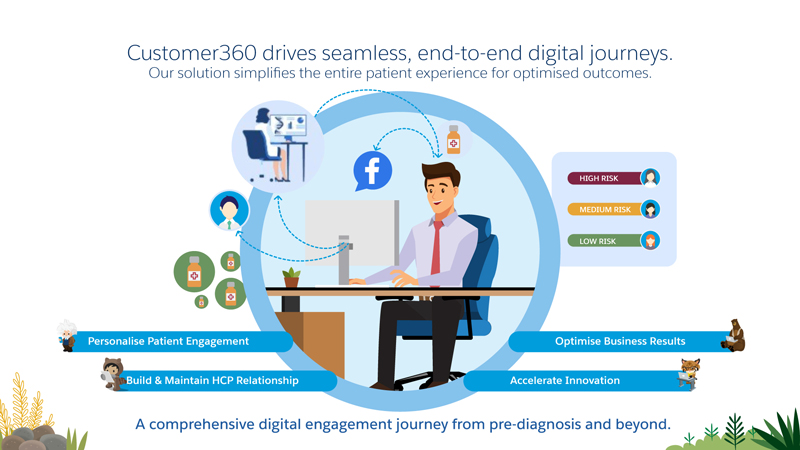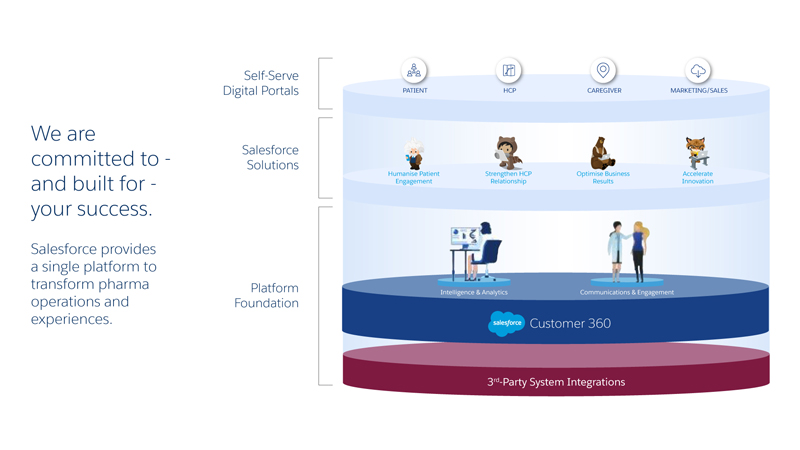We tend to think of healthcare in terms of patient-doctor engagement. A patient visits the doctor, gets a prescription, takes the medicine, and feels better. But behind the scenes, there are so many touchpoints that have to be seamlessly orchestrated to ensure that the patient receives the right treatment at the right time. Here’s a broad breakdown of those components.

COVID-19 puts pharma in the spotlight
While the pharma industry has always been important to health and wellness, its impact was especially evident during the COVID-19 breakout. All eyes were on pharma companies as they raced against time to develop medicines that would treat the disease, along with vaccines that would control it. Terminology around molecules, bio-molecules, DNA, and m-RNA recombinants became part of our collective vocabulary.
Globally, the first COVID-19 vaccine to be approved for emergency use was developed by an American pharma giant with a German biotech firm. Soon after that, India’s indigenously developed COVID-19 vaccine was cleared for use along with another licensed vaccine developed in the UK. The latter accounts for over two-thirds of the vaccinations delivered in India thus far.
For each of the competing vaccines, the success of the molecule-to-market cycle depended on multiple factors. Those vaccine developers that had proactively aligned their people, processes, and technology were able to serve humanity quicker and better than the competition.
Accelerating the pace of pharmaceutical innovation
A paper by Intouch Group and DHC Group states that “COVID has presented ‘big pharma’ with a goodwill generation opportunity that the industry has not seen in a long time. Pharma companies have a unique chance to build on this position of trust.”
Now is the time for pharma companies to take centre stage. They’ve already set the bar high through their record-breaking pace of innovation and cross-industry collaboration over the past two years. But can they sustain this level of innovation in a post-Covid world? We’ve heard from many of our customers that the industry’s inability to keep up with tech acceleration is a top concern.
Innovation, as we saw during the development of the Covid vaccines, requires better data access and stronger technology. A KPMG survey of CIOs in the pharma sector found that the top data priorities include:
- Expanding and integrating data repositories (60%)
- Scaling data analytics skills (53%)
- Increasing the organisation’s data literacy (47%)
Many of the legacy systems in pharma companies are not up to the task of meeting these objectives, and supporting a new age of innovation. The need of the hour is to connect better with patients, doctors, chemists, and other stakeholders along the healthcare cycle. That’s where Salesforce for Healthcare and Life Sciences can help.
We empower pharma companies like yours to engage with stakeholders in a whole new way. With Salesforce, you can go digital fast, collaborate seamlessly across touchpoints, uncover valuable intelligence from data, and target both physicians and patients with the information they need when they need it.
New solutions for a new era of medicine
Across the molecule-to-market cycle, we offer a sophisticated stack of solutions to accelerate innovation. Based on our industry experience and customer insights, we’ve also identified four areas of opportunity for the pharma industry to succeed in the ‘next normal’.
- Humanise patient engagement: Build a single view of the patient on a common platform, so that you can offer them personalised support, resources, and advice throughout their clinical trial journey. Create a portal where the patient can access clear and simple information on their disease, treatment, and medication guidlines. Coordinate and track interactions between providers, patients, and insurers to check that patients are receiving proper access to treatment.
- Strengthen healthcare provider relationships: Capture the communication preferences of healthcare providers, so that you can engage them when, where, and how they want to be reached. Enable seamless coordination across medical affairs, sales, service, and marketing touchpoints to deliver better value to healthcare providers.
- Optimise business results: Leverage powerful analytics and AI-fuelled predictions to monitor participation in clinical trials, track medication adherence, project revenue growth, and identify new opportunities. Use predictive analytics to identify and recruit relevant clinical trial candidates.
- Accelerate innovation: Streamline and automate the ‘ideation to therapy’ journey for optimal efficiency. Enable cross-functional reporting and predictive intelligence to uncover new opportunities for innovation. Build and scale APIs faster across enterprise applications, so that teams can share data faster and more seamlessly.

While there isn’t a one-size-fits-all approach to innovation, it certainly helps to have a system of engagement that can connect all patient-provider touchpoints. So, you can coordinate processes better to deliver exceptional experiences.
Here are two other priorities to consider in a post-COVID-19 world..
- Many companies have embarked on patient-centricity, healthcare provider engagement.
- New opportunities are seen with a connected healthcare ecosystem, personalised and data-driven experiences, and virtual clinical trials.
How are we helping pharma organisations achieve these priorities?
- We offer the power of the Salesforce platform to help customers fuel growth and innovation. The robust Salesforce platform offers multi-tenancy and three releases each year, continuously enabling you to leverage cutting-edge features to drive your digital transformation.
- We integrate our platform with external systems to help you make sense of all the data available to your organisation.
- We embed this data into our platform or services to help you orchestrate exceptional experiences for end-patients, partners, and external stakeholders.
- We enable you to collaborate in real time with patients, doctors, healthcare professionals, partners, and vendors, thus strengthening relationships.






